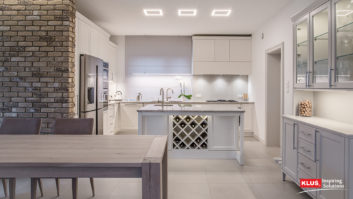The show can’t begin until the lights dim,” says one lighting control manufacturer’s home theater-related advertising and promotional literature. How true. After all, no one is going to plunk down $10 per person to sit and watch the latest box office extravaganza with the house lights on full. Savvy home theater consumers realize and appreciate the importance of authenticity, which is why lighting controls have become a crucial piece of the home theater puzzle.
But that doesn’t have to be the extent of it. Although the home theater boom of the past decade has raised awareness of lighting controls, the market remains sorely under-penetrated. In fact, home theater lighting control can merely be the beginning of a much more rewarding experience–for consumers and installers alike. In a word, lighting controls may be the great hidden treasure of the home technology market.
Perhaps the biggest advantage lighting controls offer is the ability to accommodate any installation without breaking the bank. While a lot of attention has been paid in recent years to fully integrated, whole-home lighting control systems (and for good reason, because those technologies are truly amazing), major developments have also taken place with smaller scale controls that have given installers the ability to specify them for anything from a single lamp to an entire room, which, of course, can serve as the initial steps toward a whole-home system.
And, as with most things these days, there is some impressive math to support the profitability potential lighting controls offer. For the sake of example, let’s assume a basic toggle switch costs between 50 cents and $2.50, and generally offers a 20 percent profit per switch. If you specify 30 $1.00 switches, you make a $6 profit. Dimmers are priced at (again, for the sake of example) $15 to $30 each, with profits of usually 50 percent. So by replacing just 5 of the 30 switches with $30 dimmers, your profit will be increased by $75.00 (per home). All this for some basic wallbox dimmers.
Once people experience lighting controls, they’re generally hooked. It’s getting them to take that initial step that is often difficult. But for about $20, a homeowner can enjoy entry-level lighting control with a wireless, remote-controlled lamp dimmer on a nightstand, desk, end table, (or anywhere there’s a lamp!) It’s a great way to introduce someone to the genre-plug the lamp’s plug into the dimmer’s cord and then plug the dimmer’s cord into the wall.
From there it’s a logical step-up to whole-room control. Even the most tech-savvy homeowner will be astounded at what $300 to $500 will buy: whole-room controls that can be operated from a learnable remote or a touch screen, even some that can interface with A/V equipment to satiate a home theater beginner who’d rather take baby steps than go for the whole enchilada at once. Newly introduced ‘smart dimmers’ offer a number of cool options in a unit that fits in a traditional wall opening. For less than $50 a pop, smart dimmers provide microprocessor technology that allows multi-location dimming, user-preset light levels, variable fade times, and convenient tap-on, tap-off operation. Installation is generally a simple three-wire process.
From a profitability standpoint, the good news for installers is that any (or, perhaps more accurately, every) home-not just those with home theaters-is fertile ground for lighting controls. Virtually all of the living spaces in any installation can benefit from dimming. Consider these examples:
Master Bedroom
Basic lamp and wallbox dimmers can enhance the atmosphere for TV watching, reading, romance, and even light a path to the bathroom for those otherwise-clumsy, middle-of-the-night nature calls.
Nursery
Adjustable light levels make any room more functional, but they can be a parent’s best friend in an infant’s room. Use soft lighting to help rock a little one to sleep and then check in on them later without waking them. Brighten the lights for changing time and cleaning.
Child’s Room
Sleeping with the lights on keeps away the monsters under the bed and in the closet, but it’s often difficult to nod off with the lights on full. A simple dimmer provides enough light to keep the ghosts at bay and can actually sooth toddlers to sleep.
Bathroom
Lighting controls have enjoyed increased popularity in bathrooms and home spas in recent years because they’re more practical than candles for those times when you need a good soak to ‘take you away.’ Dimmed lighting or lights that slowly fade to full intensity are also preferable to the slap-in-the-face brightness that ‘on/off’ switches offer during late night bathroom visits.
Hallways
Not a space most people focus on when it comes to lighting, but hallways equipped with path lighting operated by a dimmer or other control offer increased safety and serve as reliable nightlights.
Kitchen
Kitchens are one of the most overlooked rooms in any home when it comes to lighting controls, but the opportunities are numerous. The modern kitchen is the nerve center of practically every home. Brighter light levels can better accommodate food preparation, while lower levels offer a more intimate setting for dining. Homework and impromptu family gatherings may require lights to come back up full.
Dining Room
If existing homes have one dimmer switch, it’s most likely in the dining room. And with good reason: people seek to recreate the intimate atmosphere of a restaurant in the dining room even more than they try to replicate the environment of a cinema in their home theaters. Why not suggest an upgrade to a modern lighting control that can better create drama and add a touch of elegance for entertaining, holidays and dinner parties?
Living Room/Family Room
Another key space in most houses that can benefit from adjustable light levels to accommodate any variety of activities. Lower the lights for movie or TV watching, raise them for playtime, and dim them down again for entertaining.
While lighting control technology has evolved step-for-step with its audio, video and other consumer electronics’ counterparts, so too has lighting control design and appearance. For those concerned that they have to sacrifice aesthetics in order to have the latest gear; a new era is indeed upon us. In fact, certain lighting controls on the market today can actually be incorporated into the look of a room and used as decorative elements in and of themselves. At least one manufacturer offers more than 50 colors and finishes, ranging from classic and contemporary, (hues such as Kiwi and Lilac), to beautiful metals like Satin Brass and Satin Nickel. For a comprehensive look, homeowners can also choose from a complete line of color-matched accessories that allow them to coordinate wallplates, phone and cable jacks, GFCI receptacles, standard receptacles and switches, with the color of each room.
Despite some prevailing theories, a lighting control install obviously doesn’t have to be an all-or-nothing proposition. A lamp dimmer here, a whole-room system there, a little at a time, and eventually a residence is primed for the next logical step-tying it all together with a comprehensive whole-home system. After users have had an opportunity to experience and appreciate the various advantages lighting controls offer on a room-by-room basis, they’ll likely be eager to take the plunge for a more comprehensive system that will offer them such cool features as: operating lighting from the car, operating every light in the home from a nightstand master control, integrating lighting with security systems, adjusting lights from a telephone and programming lights to mimic normal usage patterns while on vacation.
Clearly, lighting controls are advantageous for all involved. End users generally grow to wonder how they ever lived without them and installers stand to benefit greatly from a profitability standpoint. Considering all of the advancements that have been made in the lighting controls industry-technical and otherwise-in recent years, it’s safe to assume that there is a solution for virtually any space and situation-not just the home theater market. And it’s practically a no-brainer to incorporate them into every job, even if it means doing it one light at a time.
John Forney is vice president of Residential Market Development, Lutron Electronics Co. Inc.






